Research Areas
Our laboratory pursues research in the field of nanoscale chemistry. Our current research interest include microwave chemistry to develop rapid and scalable approaches for various high quality carbon nanomaterials, especially graphene and carbon nanotubes with controlled size, porous structures and heteroatomic doping. We explore the unique properties of these carbon nanomaterials with innovative programmed assembly strategies to integrate with other nanomaterials and achieve high performance applications in batteries, catalysts, molecular sensors and multifunctional drug delivery systems. We engage in research in the following three specific areas:
- Microwave enabled rapid and controlled fabrication of nanomaterials, especially carbon based nanomaterials, such as graphene with controlled sizes, porous structures and heteroatomic doping.
- Programmed nanomaterials assembly for battery applications and catalysts.
- Multifunctional and combinational drug delivery systems.
Selected Publications
- Chao Luo, Ruiming Huang, Ruslan Kevorkyants, Michele Pavanello, Huixin He, and Chunsheng Wang “Self-Assembled Organic Nanowires for High Power Density Lithium Ion Batteries” Nano Letters, 2014, 14, 1596–1602
- Patel. M.A., Hao, Y., Chiu, P. L., Mastrogiovanni, D.D.T., Flach, C., Savaram, K., Gomez, L., Hemnarine, A., Mendelsohn, R., Garfunkel, E., Jiang, H., He, H. X. “Direct Production of Graphene Nanosheets for Near Infrared Photoacoustic Imaging” ACS Nano, 2013, 7, 8147–8157
- Chiu, P. L., Mastrogiovanni, D. D. T., Wei, D., Louis, C., Jeong, M., Yu, G., Saad, P., Flach, C. R., Mendelsohn, R., Garfunkel, E. He, H. X. “Microwave- and Nitronium Ion-Enabled Rapid and Direct Production of Highly Conductive Low-Oxygen Graphene” J. AM. Chem. Soc. 2012, 134, 5850-5856
Research Highlights
π-Plasmon of Carbon Nanotubes for Selective and Sensitive Detection of Fe3+ Ions
William Cheung, Mehulkumar Patel, Yufeng Ma, Yuan Chen, Qiaoqiao Xie, Jenny Lockard, Yuan Gao and Huixin He,
Chemical Science

For the first time, we found that the strong π-plasmon absorption of SWNTs in the ultraviolent region is extremely sensitive to ion binding. It is even much more sensitive than the absorption in visible and NIR regions. Herein, we present our first exploration in using the extremely strong plasmon absorption of SWNTs to develop a new sensing platform for detection of metallic ions. The detection selectivity is realized by modifying the surface of SWNTs with molecular ligands with high specificity for metal ions. As a demonstration, the new method is applied to selectively detect iron ions (Fe3+) by modifying the surface of the SWNTs with deferoxamine (DFO), a natural bacterial siderophore, which has a high specificity and affinity for Fe3+. Selective detection of Fe3+ in both aqueous solution and complex rain water is achieved with pM level of sensitivity and detection limits. In-situ Resonant Raman Spectroscopy demonstrated that the sensitive detection possibly involves electron transfer between the formed Fe-DFO complexes and SWNTs. We envision that it can be used to detect other metal ions when a specific binding chelator is attached to the carbon nanotube surface.
P-Doped Porous Carbon as Metal Free Catalysts for Selective Aerobic Oxidation with an Unexpected Mechanism
Mehulkumar A. Patel, Feixiang Luo, M. Reza Khoshi, Emann Rabie, Qing Zhang, Carol R. Flach, Richard Mendelsohn, Eric Garfunkel, Michal Szostak, and Huixin He,
ACS Nano 10 no. 2 (2016): 2305-2315.

An extremely simple and rapid (seconds) approach is reported to directly synthesize gram quantities of P-doped graphitic porous carbon materials with controlled P bond configuration. Phytic acid, the principal storage form of phosphorus (P) in many plant tissues, can be directly used for P doped carbon material fabrication with microwave energy. The existence of both high levels of C and P in one molecule ensures uniform P doping in the fabricated carbon materials. Most importantly, since phytic acid strongly absorbs microwave energy, the as-purchased phytic acid solution can be directly subjected to short (40 seconds) microwave irradiation to give rise to the P doped graphene like carbon product (PGc). By simply changing the microwave irradiation time, PGc with different P bond configuration, which determines the catalytic centres, are obtained. Microwave heating instead of traditional heating ensures that the approach is both sustainable and low energy cost. Furthermore, the fabrication can be performed in air under ambient conditions without the requirement of inert environment, which makes this approach even more cost effective and convenient. For the first time, it is demonstrated that the P-doped carbon materials can be used as a selective metal free catalyst for aerobic oxidation reactions. The work function of P-doped carbon materials, its connectivity to the P bond configuration, and the correlation with its catalytic efficiency are studied and established. In direct contrast to N-doped graphene, the P-doped carbon materials with higher work function show high activity in catalytic aerobic oxidation. The selectivity trend for the electron donating and withdrawing properties of the functional groups attached to the aromatic ring of benzyl alcohols is similar to those metal based catalysts, but very different from other metal free carbon based catalysts. A unique catalytic mechanism is demonstrated, which differs from both GO and N-doped graphene obtained by high temperature nitrification. The unique and unexpected catalytic pathway endows the P-doped materials with not only good catalytic efficiency but also recyclability. Significantly, this rapid microwave-assisted carbonization approach can be extended to fabricate P co-doped carbon catalysts such as P-N, P-S, P-Si, and P-B co-doped carbon materials, by simply adding a suitable dopant precursor into phytic acid solution prior to microwave irradiation. Even though the fabrication of carbon materials without P doping, is not straight forward by this microwave assisted carbonization technique, because the available precursors for these materials are transparent to microwave irradiation, carbon nanomaterials without heteroatom doping, or doping only with one type of heteroatom such as S, Si, B or N, were successfully fabricated.
An Ion-Exchange Promoted Phase Transition in a Li-Excess Layered Cathode Material for High-Performance Lithium Ion Batteries
Jianqing Zhao, Ruiming Huang, Wenpei Gao, Jian-Min Zuo, Xiao Feng Zhang, Scott T. Misture, Yuan Chen, Jenny V. Lockard, Boliang Zhang, Shengmin Guo, Mohammad Reza Khosh, Kerry Dooley, Huixin He, and Ying Wang,
Advanced Energy Materials 5, no. 9 (2015).

Taking advantage of our rich experience in exfoliation of 2D materials such as graphene and layered transition metal oxides, we developed an ex-situ approach which is promoted by extensive ionic exchange to purposely induce a layered-to-spinel phase transformation in LMNCO. This approach allows us to fundamentally study the mechanism of the layered-to-spinel phase transition, to detailed characterize the crystal structure, and to evaluate the battery performance of the resulting spinel phase. Collaborating with Prof. Ying Wang in Louisiana State University and Dr. Xiaofeng Zhang from Hitachi High Tech, in-situ X Ray Diffraction (XRD) and in-situ high resolution transmission electron microscopy (TEM) were used to fundamentally understand the phase transition. We found that the generation of sufficient lithium ion vacancies at a time within the Li-excess layered oxide plays a critical role for realizing a complete phase transition. This scenario cannot be achieved via in-situ electrochemical cycling, during which only limited Li vacancies could be created during each charge/discharge cycle. We identified the spinel structure obtained in this work is Li4Mn5O12 -type spinel, different from the spinel structure (LiMn2O4 type) from in-situ electrochemical cycling. Impressively, the newly formed spinel cathode not only exhibits much high discharge capacity than the pristine Li-excess layered cathode it can retain much higher specific capacity, demonstrating remarkably improved rate capability and cycling stability in comparison with the original Li-excess layered cathode materials. It is noteworthy that the discharge capacity and rate performance are also much better than pure Li4Mn5O12 and currently commercially used LiMn2O4 spinel, demonstrating a leap forward for practical applications. We also found that the existence of Ni and Co elements as well as its mesoporous structure in the newly formed spinel by this approach helps to stabilize the basic Li4Mn5O12 spinel structure, and thus contributes to the desirable cycleability.
Graphene-Catalyzed Direct Friedel-Crafts Alkylation Reactions: Mechanism, Selectivity and Synthetic Utility
Hu, Feng, Mehulkumar Patel, Feixiang Luo, Carol Flach, Richard Mendelsohn, Eric Garfunkel, Huixin He, and Michal Szostak.
J. Am. Chem. Soc 137, no. 45 (2015): 14473-14480.

Collaborating with Prof. Michal Szostak’s group, we explored graphene oxide (GO) as metal free heterogeneous catalysts for direct Friedel-Craft alkylation reactions. We report the first general strategy for alkylation of arenes with unactivated olefins and alcohols catalyzed by GO. The unique molecular structure of GO promotes the synthesis of valuable diarylalkane products in high yields and excellent regioselectivity. The protocol is characterized by a wide substrate scope and excellent functional group tolerance. Notably, this process constitutes the first general application of graphenes to catalyze direct C–C bond formation utilizing polar functional groups anchored on the GO surface, thus opening the door for an array of functional group alkylations using benign and readily available graphene materials. Mechanistic studies suggest that the reaction proceeds via a tandem catalysis mechanism in which both of the coupling partners are activated by interaction with the GO surface.
Microwave Enabled One-Pot, One-Step Fabrication and Nitrogen Doping of Holey Graphene Oxide for Catalytic Applications
Mehulkumar Patel, Wenchun Feng, Keerthi Savaram, Mohammad Reza Khosi, Ruiming Huang, Jing Sun, Emann Rabie, Carol flach, Richard Mendelsohn, Eric Garfunkel,
Small 11, no. 27 (2015): 3358-3368. This article is featured as fronties piece in special issue of “Small” journal, April 2015.

The unique properties of holey graphene sheet, referred to graphene sheet with nanoholes in its basal plane, lead to wide range of applications, which cannot be achieved by its non-porous counterpart. However, its large scale solution based production requires graphene oxide (GO) or reduced GO (rGO) as starting materials, which take hours to days for their fabrication. Based on the fundamental understanding of the roles of KMnO4 and nitronium ions in microwave assisted oxidation of graphite, in this work, we develop a rapid approach to controllably fabrication GO with or without holey structures directly from graphite powder. By intentionally including KMnO4 back to the nitronium oxidation system and controlling the microwave irradition time, graphene oxide sheets without holes (ME-GO), and with holes (Holey ME-GO) in their basal planes can be rapidly fabricated with high production yield. Again, by taking advantage of the unique heating mechanism of microwave, we also developed a fast and low temperature approach to simultaneously reduce and dope graphene oxide sheets with nitrogen. This N doped holey graphene shows the very good catalytic activity toward electrochemical oxygen reduction reaction (ORR) due to the existence of nanoholes.
Synergy of Oxygen and Piranha Solution for Eco-Friendly Production of Highly Conductive Graphene Dispersions
Keerthi Savaram, Malathi Kalyanikar, Mehulkumar Patel, Roman Brukh, Carol R. Flach, Ruiming Huang, M.Reza Khoshi, Richard Mendelsohn, Andrew Wang, Eric Garfunkel, and Huixin He
Green Chemistry, 2015, 2, 1197-1204.

In this project, we studied microwave assisted oxidation chemistries by molecular oxygen and piranha solution (a mixture of H2SO4 and H2O2). We found that the synergy of the intercalated oxygen and the piranha solution enables controlled oxidation of graphite intercalation compounds, which also leads to the rapid (60 seconds) and direct generation of highly conductive low oxygen containing graphene sheets. This approach not only keeps all the merit of the nitronium oxidation approach we developed before. Most importantly, the intrinsic molecular oxidation mechanism leads to an eco-friendly fabrication of highly conductive graphene sheets without generating toxic byproducts, which ensures mass production of high quality graphene dispersions with low environmental footprints and at a much lower cost. Therefore we referred the sheets fabricated by this eco-friendly approach as Eco-ME-LOGr. On the other hand, the dispersibility in various organic solvents is different, which indicates that oxygen containing functional groups on graphene sheets differ from ME-LOGr. These results suggest that oxygen containing functional groups can be comfortably altered by changing the chemical recipes using the fast microwave chemistry.
Self-Assembled Organic Nanowires for High Power Density Lithium Ion Batteries
Chao Luo, Ruiming Huang, Ruslan Kevorkyants, Michele Pavanello, Huixin He, and Chunsheng Wang ,
Nano Letters, 2014, 14, 1596-1602.
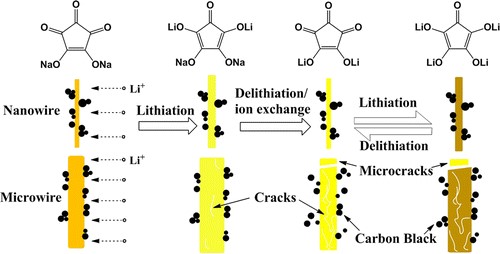
In this work, Croconic acid disodium salt (CADS) was used as Li-ion battery electrode, and CADS organic wires with different diameters were fabricated through a facile synthetic route using antisolvent crystallization method to overcome the challenges of low electronic conductivity of CADS and lithiation induced strain.The CADS nanowire exhibits much better electrochemical performance than its crystal bulk material and microwire counterpart. CADS nanowire with a diameter of 150 nm delivers a reversible capability of 177 mAh/g at a current density of 0.2 C and retains capacity of 170 mAh/g after 110 charge/discharge cycles.
Direct Production of Graphene Nanosheets for Near Infrared Photoacoustic Imaging
Patel. M.A., Hao, Y., Chiu, P. L., Mastrogiovanni, D.D.T., Flach, C., Savaram, K., Gomez, L., Hemnarine, A., Mendelsohn, R., Garfunkel, E., Jiang, H., He, H. X.,
ACS Nano, 2013, 7, 8147-8157.
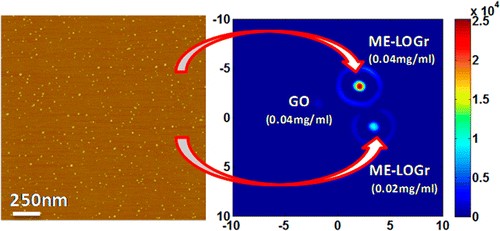
In this work, By intentionally excluding KMnO4 and exploiting pure nitronium ion oxidation, aided by the unique thermal and kinetic effects induced by microwave heating, we find that graphite particles can be converted into graphene nanosheets with their pi-conjugated aromatic structures and properties largely retained.The as fabricated nanographene exhibited strong absorption, which is nearly wavelength-independent in the visible and near-infrared (NIR) regions, an optical property typical for intrinsic graphene sheets. For the first time, we demonstrate that strong photoacoustic signals can be generated from these graphene nanosheets with NIR excitation.
Microwave- and Nitronium Ion-Enabled Rapid and Direct Production of Highly Conductive Low-Oxygen Graphene
Chiu, P. L., Mastrogiovanni, D. D. T., Wei, D., Louis, C., Jeong, M., Yu, G., Saad, P., Flach, C. R., Mendelsohn, R., Garfunkel, E. He, H. X. ,
J. AM.Chem. Soc. , 2012, 134, 5850-5856.
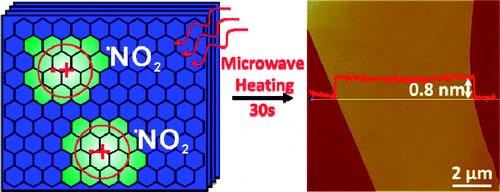
In this work, we report an unprecedented fast and scalable approach to fabricate conductive graphene sheets. In this approach, nitronium ions combined with the unique properties of microwave heating was explored. This combination promotes rapid and simultaneous oxidation of multiple non-neighboring carbon atoms across an entire graphene sheet, thereby producing only a minimum concentration of oxygen moieties sufficient to enable the separation of graphene sheets.
Labile Catalytic Packaging of DNA/siRNA: Control of Gold Nanoparticles "out" of DNA/siRNA ComplexesAlex M. Chen, Zhang, M., Oleh Taratula, Dongguang Wei, Thresia Thomas, T. J. Thomas, Tamara Minko, and Huixin He.,
ACS Nano, 2010, 4, 3679-3788.
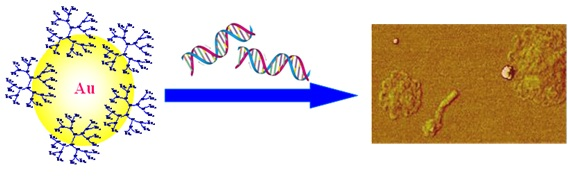
In this work, we report an interesting finding that Au nanoparticles (NPs) physically anchored with several low generation polypropylenimine (PPI) dendrimers can effectively assemble DNA/siRNA into discrete nanopartcles, where the Au NPs can be controlled "out" of the final DNA/siRNA nanoparticles. Therefore it becomes possible to eliminate the potential toxic problems associated with Au NPs by selectively removing the Au NPs from the resulting nucleic acid complexes before their delivery to targeted cells. This is a new concept of using engineered inorganic nanoparticles for DNA/siRNA condensation and delivery. In contrast to the siRNA nanostructures (mainly random aggregated nanofibers) formed from low generation dendrimer alone (PPI Generation 3), the siRNA complex nanoparticles packaged by this novel approach (Au nanoparticles modified with G3 PPI dendrimers) can be internalized by cancer cells and the delivered siRNAs can effectively silence their targeted mRNA. The efficiency of mRNA silencing by the proposed nanoparticles is even superior to higher generation dendrimers (PPI Generation 5).
Simple Production of Graphene Sheets by Direct Dispersion with Aromatic Doping and Healing Agents
Ming Zhang, Rishi R. Parajuli, Daniel Mastrogiovanni, Boya Dai, Phil Lo, William Cheung, Roman Brukh, Pui Lam Chiu, Tao Zhou, Zhongfan Liu, Eric Garfunkel, and Huixin He.
Small, 2010, 6, 1100-1107. .
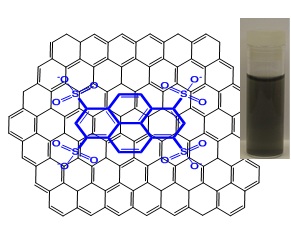
In this work, we report a simple and scalable exfoliation approach to produce high quality single layer graphene sheets. In a typical experimental procedure, graphite powders were exfoliated by sonicating in an aqueous solution of pyrene molecules that had been functionalized with different water soluble groups. Highly conductive graphene sheets stabilized in aqueous suspensions were directly produced without requiring toxic reducing agents and expensive solvents. Most importantly, different from other surfactants and polymers, that has been used to prevent graphene sheets from aggregation in solution, the pyrene molecules also act as nanographene molecules to heal the possible defects in the graphene sheets during annealing. Remarkably, they also appear to act as electrical "glue" soldering adjacent graphene sheets such that electric contacts between graphene sheets can be dramatically improved across the film. Graphene films with conductivity of 181,200 S/m (778 Ω/square) with light transmittance greater than 90% in the 400-800 nm wavelength range are reproducibly obtained, which is the highest conductivity values ever achieved for graphene films fabricated by graphite exfoliation approaches (note that graphene films fabricated by chemical vapour deposition (CVD) method can reach 200 Ω/square at 80% optical transparency). Nevertheless, this simple and scalable approach is extremely promising to produce high quality graphene films for a wide range of optoelectronic applications, including photovoltaics.
Co-delivery of Doxorubicin and siRNAs into Multidrug Resistant Cancer Cells by Mesoporous Silica Nanoparticles for Enhanced Chemotherapy Efficacy
Alex M. Chen, Min Zhang, Dongguang Wei, Dirk Stueber, Oleh Taratula, Tamara Minko, and Huixin He.
Small, 2009, 5, 2673-2677..
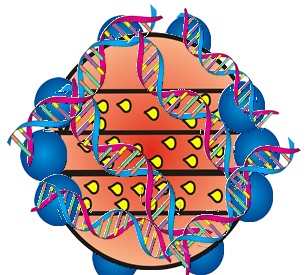
In this work, we explored to utilize mesoporous silica nanoparticles (MSNs) to co-deliver doxorubicin (Dox) (as a model apoptosis-inducing anticancer drug), and a siRNA (as a suppressor of cellular antiapoptotic defense) simultaneously into multidrug resistant cancer cells for efficient cancer therapy. As illustrated in Scheme, the MSNs were modified to encapsulate Dox inside the pores to achieve minimal premature drug release. Then the Dox-loaded MSNs were modified with generation 2 (G2) amine-terminated polyamidoamine (PAMAM) dendrimers. The dendrimer-modified MSN can efficiently complex with siRNAs targeted against mRNA encoding Bcl-2 protein, which is the main player for nonpump resistance. We found thus-formed complex can be delivered into multidrug resistant A2780/AD human ovarian cancer cells to induce cell death. The anticancer efficacy of Dox increased 132 times compared to free Dox, mainly because the simultaneously delivered siRNA significantly suppressed the Bcl-2 mRNA, and efficiently overcome the nonpump resistance. Moreover, our data suggested that the delivered Dox by the MSNs are primarily localized in perinuclear region upon internalization, providing additional advantage in possibly bypassing pump resistance, therefore further enhancing the drug efficacy. This result is much different from some liposome co-delivery systems, in which antisense oligonucleotides targeted to pump and nonpump resistances must be simultaneously delivered in order to significantly increase drug efficacy. We attributed this difference to the different internalization pathway and drug release mechanism. We envisioned that this co-delivery system can be generalized to other anticancer drugs and other cancer cell lines.
Anti-HER2 IgY Antibody-Functionalized Single-Walled Carbon Nanotubes for Detection and Selective Destruction of Breast Cancer Cells
Xiao, Y., Gao, X., Taratula, O., Treado, S., Mitra, S., Salva, R., Wagner, P. D., Srivastava, S., He, H. X.
BMC Cancer, 2009, 9, 351 (1-11)..
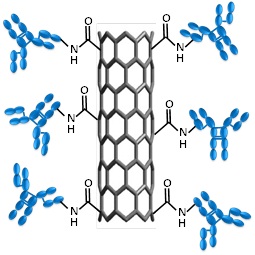
In this work, anti-HER2 IgY-SWNT complexes were constructed by covalently conjugating carboxylated SWNTs with anti-HER2 chicken IgY antibodies, which are more specific and sensitive than mammalian IgGs. We demonstrated the dual functionality of the complex for both detection and selective destruction of cancer cells in an in vitro model. Raman signal collected at single-cell level from the complex-treated receptor-positive breast cancer cells was significantly greater than that from various control cells. Near Inferred (NIR) irradiation selectively destroyed the complex targeted breast cancer cells without harming receptor-free cells. The cell death was effectuated without the need of internalization of SWNTs by the cancer cells, a finding that has not been reported previously.
Surface-Engineered Targeted PPI Dendrimers for Efficient Intracellular and Intratumoral siRNA delivery
Taratula, O., Garbuzenko, O. B., Kirkpatrick, P., Pandya, I., Savla, S., Pozharov, V. P., He, H. X., Minko, T.
Journal of Controlled Release, 2009, 140, 284-293..

Low penetration ability of Small Interfering RNA (siRNA) through the cellular plasma membrane combined with its limited stability in blood plasma, limits the effectiveness of the systemic delivery of siRNA. In order to overcome such difficulties, we constructed a nanocarrier-based delivery system by taking advantage of the lessons learned from the problems in the delivery of DNA. In the present study, siRNA nanoparticles were first formulated with poly(propyleneimmine) (PPI) dendrimers. To provide lateral and steric stability to withstand the aggressive extracellular environment, the formed siRNA nanoparticles were caged with a dithiol containing crosslinker molecules followed by coating them with PEG polymer. A synthetic analog of Luteinizing Hormone-Releasing Hormone (LHRH) peptide was conjugated to the distal end of PEG polymer to direct the siRNA nanoparticles specifically to the cancer cells. Our results demonstrated that this layer-by-layer modification and targeting approach confers the siRNA nanoparticles extracellular stability and intracellular bioavailability, provides for their specific uptake by tumor cells, accumulation of delivered siRNA in the cytoplasm of cancer cells, and the efficient gene silencing. In addition, in vivo body distribution data confirmed high specificity of the proposed targeting delivery approach which created the basis for the prevention of adverse side effects of the treatment.
Improved Conductivity of Carbon Nanotube Networks by In-situ Polymerization of a Thin Skin of Conducting Polymer
Ma, Y. F., Cheung, W., Wei, D. G., Bogozi, A., Chiu, P. L., Wang, L., Pontoriero, F., Mendelshon, R. and He, H. X.
ACS Nano, 2008, 2, 1197-1204..
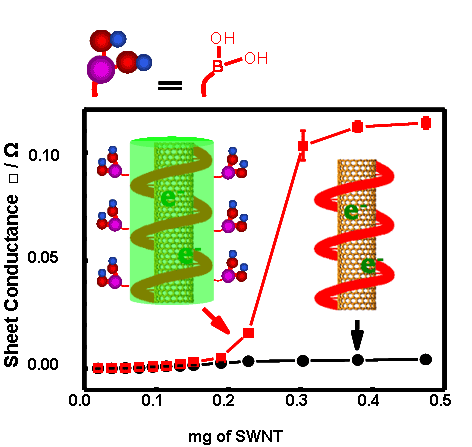
There is increasing enthusiasm for the use of carbon nanotube network films as conductive flexible electrodes for a wide variety of applications. However, all the reported conductivities of the single walled carbon nanotubes (SWNTs) network films were significantly lower than the conductivity of a carbon nanotube rope (axial conductivity). This has been attributed to the high contact resistance between the tubes in the networks. Tremendous efforts have been made over the past decade to prepare polymer and carbon nanotube composites with an aim to synergistically combine the merits of each individual component. However, all the reported composites show enhanced conductivity over the polymeric side, much lower electronic performance when compared to the carbon nanotube network film side. In this work, we have demonstrated experimentally, for the first time, that in-situ polymerization of a thin skin of highly conductive polymer around and along the SWNTs can greatly decrease the contact resistance. The polymer skin also acts as conductive glue effectively assembling the SWNTs into a conductive network, which decreased the amount of SWNTs needed to reach the high conductive regime of the network. The highly conductive composite network and the method to fabricate the highly conductive composite can be widely used for large area flexible electronics, including flexible solar cells, and organic light emitting devices.
The Electronic Role of DNA Functionalized Carbon Nanotubes: Efficacy for In-situ Fabrication of Conducting Polymer Nanocomposites
Ma, Y. F., Chiu, P. L., Serrano, A., Ali, S. K., Chen, A. M, and He, H. X.
J. Am. Chem. Soc. 2008, 130, 7921-7928..
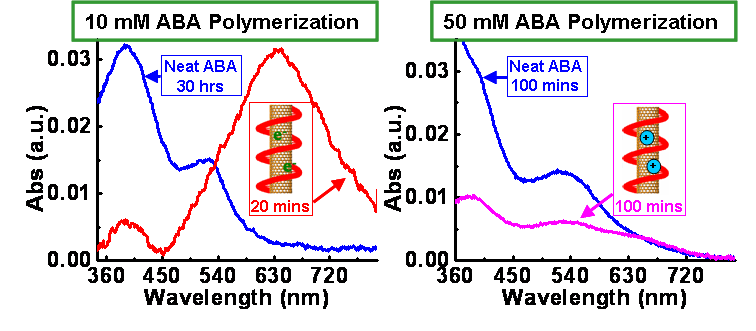
To truly synergistically combine the merits of each individual component in the conducting polymer nanocomposites, it is essential to understand the monomer-nanotube interfacial chemical and electronic interactions during polymerization and polymer-nanotube interfacial interactions after the polymerization, which has not been fully addressed.
Taking advantages of the well-documented surface chemistry and electronic structure of single stranded DNA dispersed and functionalized single walled carbon nanotubes (ss-DNA-SWNTs), we systematically studied the impacts of the electronic structure of a carbon nanotube and the monomer-nanotube interfacial interaction on the kinetics of the nanocomposite fabrication and the quality of the obtained composites. For the first time, we found that the polymerization process can be 4,500 times faster and much less oxidant needed to initiate the reaction when a conducting polymer was polymerized in the presence of intact ss-DNA-SWNTs, which are electron rich. More importantly, the quality of the composite was synergistically improved, as demonstrated by the significantly enhanced electrical performance of the obtained nanocomposite. However, the synergistic conductance enhancement cannot be obtained by simply mixing a preformed conducting polymer with the ss-DNA/SWNTs. Surprisingly, the enhancement was not achievable by in-situ polymerization with pre-oxidized SWNTs, which are electron deficient. In addition, the polymerization process is also much slower in the presence of pre-oxidized ss-DNA-SWNTs. Understanding these reaction characteristics is important to effectively optimize the fabrication parameters and ensure the formation of composites in a controllable fashion for a variety of potential applications. Based on these remarkable observations, currently they are developing a greener approach for the fabrication of nanocomposites.
In-situ Fabrication of A Water-Soluble, Self-Doped Polyaniline Nanocomposite: the Unique Role of DNA Functionalized Single-Walled Carbon Nanotubes
Yufeng Ma, Shah K Ali, Ling Wang, Pui Lam Chiu, Richard Mendelsohn and Huixin He,
J. Am. Chem. Soc. 2006, 128, 12064-12065. .
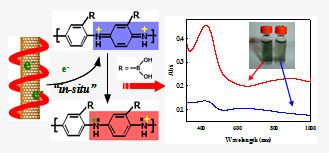
Dispersion of carbon nanotubes into solvents affects their surface chemistries, electronic structures, and subsequent functionalization. In this communication, a water-soluble self-doped polyaniline nanocomposite was fabricated by in-situ polymerization of the 3-aminophenylboronic acid monomers in the presence of single-stranded DNA dispersed- and functionalized- single-walled carbon nanotubes. For the first time, we found that the carbon nanotubes became novel active stabilizers due to the DNA functionalization. The nanotubes reduced the polyaniline backbone from the unstable, degradable, fully oxidized pernigraniline state to the stable, conducting emeraldine state due to their reductive ability, which could improve the chemical stability of the self-doped polyaniline. Electrical measurements demonstrate that the conductivity of the nanocomposite was much higher than that of the pure self-doped polyaniline in both acidic and neutral solutions.
Enhanced Sensitivity for Biosensors: Multiple Functions of DNA Wrapped Single Walled Carbon Nanotubes in Self-Doped Polyaniline Nanocomposites
Yufeng Ma, Shah R Ali, Afua S. Dodoo, and Huixin He,
J. Phys. Chem. B, 2006, 110, 16359-16365..
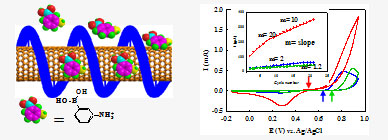
A nanocomposite of poly(anilineboronic acid), a self-doped polyaniline, with ss-DNA wrapped single walled carbon nanotube (ss-DNA/SWNTs) was fabricated on a gold electrode by in-situ electrochemical polymerization of 3-aminophenylboronic acid monomers in the presence of ssDNA/SWNTs. We used this nanocomposite to detect nanomolar concentrations of dopamine and found that the sensitivity increased four orders of magnitude compared to the detection only neat poly(anilineboronic acid) was used to modify the electrode. For the first time, this work reports the multiple functions of the ss-DNA/SWNTs in the fabrication and biosensor application of a self-doped polyaniline/ssDNA/SWNT nanocomposite. First, the ssDNA/SWNTs acted as effective molecular templates during polymerization of self-doped polyanline so that not only was the polymerization speed increased, but also the quality of the polymer was greatly improved. Second, they functioned as novel active stabilizers after the polymerization, which significantly enhanced the stability of the film. Furthermore, the ss-DNA/SWNTs also acted as conductive polyanionic doping agents in the resulting polyaniline film, which showed enhanced conductivity and redox activity. Finally, the large surface area of carbon nanotubes greatly increased the density of the functional groups available for sensitive detection of the target analyte. We envision that polyaniline with other functional groups, as well as other conducting polymers, may be produced for different targeted applications by this approach.
Oligodeoxynucleotide nanostructure formation in the presence of polypropyleneimine dendrimers and their uptake in breast cancer cells
Alex M. Chen, Latha M. Santhakumaran, Sandhya K. Nair, Peter S. Amenta, Thresia Thomas, Huixin He, and T. J. Thomas, Published in
Nanotechnology, 2006, 17, 5449-5460..
This is a collaboration study with
Drs. Thomas at University of Medicine and Dentistry at New Jersey. We studied the efficacy of 5 generations of polypropyleneimine (PPI) dendrimers to provoke nanoparticle formation from a 21-nt antisense oligodeoxynucleotide (ODN). Nanoparticle formation was observed with all generations of dendrimers by light scattering and microscopic techniques. The efficacy of the dendrimers increased with generation number. Atomic force microscopy (AFM) was used to study the morphology of the structures at different condensation stages. Based on the observed nanofibers in the beginning of condensation, we propose a zipping condensation mechanism, which is very different from the condensation pathways of high molecular weight DNA polymers. Electron microscopy showed the presence of toroidal nanoparticles. Confocal microscopic analysis showed that the nanoparticles formed with G-4 and G-5 dendrimers could undergo facile cellular uptake in a breast cancer cell line, MDA-MB-231, whereas xparticles formed with G-1 to G-3 dendrimers lacked this ability. Nanoparticles formed with G-1 to G-3 dendrimers showed significantly lower zeta potential (5.2-6.5 mV) than those (12-18 mV) of particles formed with G-4 and G-5 dendrimers. These results show that the structure and charge density of the dendrimers are important in ODN nanoparticle formation and cellular transport and that G-4 and G-5 dendrimers are useful in cellular delivery of antisense ODN.
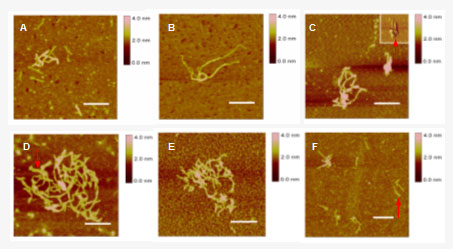 Figure 1.
Figure 1. AFM images of condensates formed by the 21-nt ODN in the presence of PPI dendrimers after 10-minute condensation. ODN had a concentration of 0.4M and dendrimer was 2.5M in a solution containing the approximate physiological concentration of salts. Panels are (A) G-1, (B) G-2, (C) G-3, (inset) Phase image with the same scale of the main image indicated by a red arrow. (D) G-4, (E) G-5, and (F) G-5. Bar represents 250 nm in all panels.
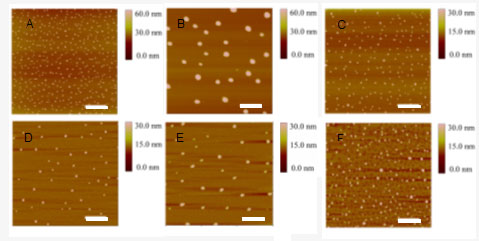 Figure 2.
Figure 2. AFM images of condensates formed by the 21-nt ODN in the presence of PPI dendrimers after 1 hour of condensation (panels A, B, C, D, E and F). ODN had a concentration of 0.4M and dendrimer was 2.5M in a solution containing the approximate physiological concentration of salts. (A) G-1, (B) G-1 (zoom image of one part of panel (A)), (C) G-2, (D) G-3, (E) G-4, (F) G-5. Bar represents 4m in panel (A), 1m in panels (B, C, D, F) and 300 nm in panel (E).
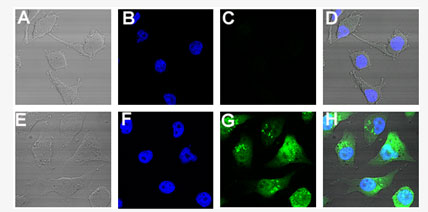 Figure 3.
Figure 3. Representative images of cellular uptake of fluorescein-labeled 21-nt ODN by MDA-MB-231 cell by confocal microscopy. ODN uptake in the absence (A, B, C, D) or the presence (E, F, G, H) of G-4 dendrimer is shown. Differential interference contrast (DIC) images of cells are shown in panels A and E. Nuclei stained with DAPI (B and F), detection of fluorescein-labeled oligonucleotide (C and G) and overlay of images (D and H) are shown. Final concentration of ODN and G-4 dendrimer in the cell culture medium were 0.2 M each.
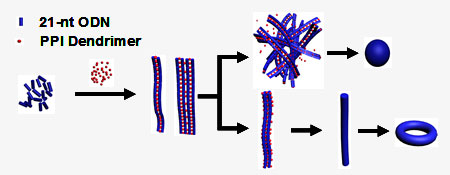 Figure 4.
Figure 4. Schematic representation of the proposed zipping mechanism for the condensation of the 21-nt ODN by PPI dendrimers. PPI dendrimers first "zip" the ODN molecules by electrostatic interactions to form extended chains. The extended chains could wrap around to form aggregated complex structures, which then further condense into spheroidal structures. The extended chains could also interact with each other in parallel to form ribbon- and rod-like structures and then wrap around to form toroidal structures.
Assembly of Highly Aligned DNA Strands onto Si Chips
Zhang, J. M., Ma, Y. F., Stachura, S. He, H. X.,
Langmuir, 2005, 21, 4180-4184..
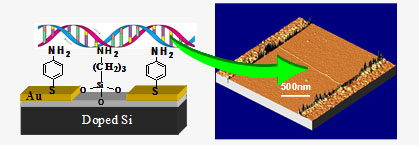
This work reports a robust and efficient approach to assemble highly aligned DNA strands onto Si chips. The method combines advantages from molecular combing and microcontact printing to realize controlling both the density and direction of DNA strands on the Si chip. In addition, it also can be utilized to prepare stretched DNA structures on solid surfaces. Compared to approaches that use molecular combing directly on silanated surfaces, the stretched single-chain DNA structures are straighter. Furthermore, by exploiting the hydrophobic property of the intrinsic poly(dimethylsiloxane) (PDMS) stamp, this study also describes a simple way to simply produce straight bundled DNA arrays on Si and other substrates.
Polyaniline Nanowires on Si Surfaces Fabricated with DNA Templates
Yufeng Ma, Jianming Zhang, Guojin Zhang and Huixin He*,
J. Am. Chem. Soc. 2004, 126, 70977101..
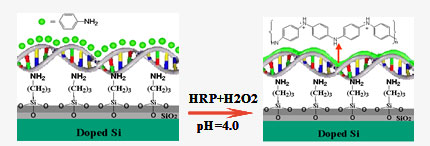
It is essential to put individual, freestanding nanowires onto insulating substrates and integrate them to useful devices. Here we report a strategy for fabrication of conducting polymer nanowires on thermally oxidized Si surfaces using DNA as templates. The direct use of stretched and immobilized DNA strands as templates avoided the agglomeration of DNA caused by shielding of charges on DNA when polyaniline/DNA complexes formed in solution. Most importantly, the oriented DNA strands immobilized on Si surface predetermined the position and the orientation of the nanowires. The approach described here is the first step toward uniting the programmable-assembly ability of DNA with the unique electronic properties of conducting polymers for high-density functional nanodevices. The conductivity of the nanowires is very sensitive to the proton doping-undoping process suggesting that the nanowires hold a great promise for sensitive chemical sensor applications.





































